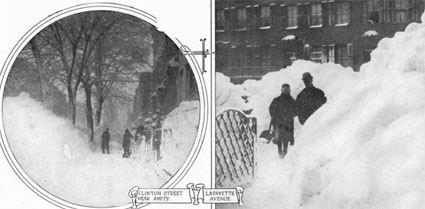On This Day in History, March 11: The Great Blizzard of ’88

Though March is usually characterized by the onset of milder temperatures, that was certainly not the case in 1888. Record snowfalls of up to 20.9 inches were created in the great blizzard, which began on March 11 and continued for three days throughout the New England eastern seaboard states.
More than 400 people either froze to death or died later from the effects of the storm. Scores of ships and fishing boats were destroyed by waves and winds that averaged 60 m.p.h., with wind gusts of up to 100 m.p.h. Property damage exceeded $7 million.
Saturday, March 10, 1888, was a bright springlike day in Brooklyn with a gentle south wind. People strolled, sat awhile on their stoops, went downtown to take advantage of winter clearance sales in the Fulton Street stores, or went to Prospect Park where the trees were just beginning to bud. Across the East River in Manhattan, Barnum & Bailey’s circus was in town and their grand pre-opening parade had left Madison Square Garden at dusk. No one would have believed what was in store for them in the next few days.